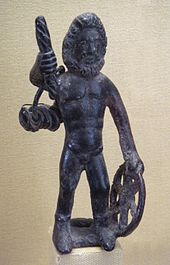Thunderbolt (mythology)
|
|
This item has been on the quality assurance side of the editorial mythology entered. Please help improve this article and join the discussion . |
|

The thunderbolt appears in numerous mythologies as the weapon of the Heavenly Father ( Zeus , Jupiter , Thor , Taranis , ...). The demon Baal is also said to have had a thunderbolt.
With the thunderbolt, the owners became masters of the lightning and the subsequent thunder . It can be used both as a weapon and as a means of controlling the weather . If it is used as a weapon, the owner throws it in a bright beam onto the earth. This explained the phenomenon of lightning at the time .
The thunderbolt has essentially two forms: it can be represented as a hammer, as in Germanic mythology, for example, or in the shape of a dumbbell, as in Roman mythology.
Greek mythology

History of origin
When Zeus fought the Titans with his siblings Poseidon, Hades, Hera and Demeter, on the advice of his mother Gaia he released the Hekatoncheiren and the Cyclops , who were trapped in Tartaros in the underworld . While the Hekatoncheiren fought the Titans together with the gods , the Cyclops created three magical things: the Hades cap as a cloak of invisibility for Hades, the trident as a scepter for Poseidon and the thunderbolt as a weapon for Zeus.
use
Since then, Zeus used the thunderbolt in important battles such as the battle with the giants (gigantomachy). Since then he has been considered a symbol of the strength and power of Zeus.
As Zeus' favorite daughter, Athena was also allowed to use the thunderbolt.
Roman mythology
As in Greek mythology, the Cyclops presented the ruler of the kingdom of gods Jupiter with the thunderbolt; like Zeus, he became master of thunder and lightning. Since then he has been responsible for the celestial phenomena, especially for the thunderstorms. The objects or places struck by lightning were considered to be Jupiter's possession and were therefore sacred. Even a person who was struck by lightning and who escaped with his life was regarded as someone whom the gods had bestowed a favor.
Vedic religion

In the Vedic religion there is a weapon very similar to the thunderbolt: the vajra . Like the thunderbolt, it is capable of throwing lightning around it - but its shape is more like a dumbbell. He was commissioned by the highest of all Vedic gods Indra and has served as his scepter ever since.
The two sides are interpreted differently in Buddhism : as matter and spirit, as day and night or as hot and cold. Its center should be the unity of all being. In addition, according to Buddhist teachings, the vajra should symbolize impenetrability, indivisibility and indestructibility, which lead to enlightenment .
For example, the Varya can be seen on India's national flag from 1905. A Buddhist movement (the Vajrayana ) is also named after the object.
Germanic and Nordic mythology

According to Germanic mythology, the father of gods Donar or Thor triggered the heavenly phenomena, especially lightning and thunder. Accordingly, he brandished the weapon Mjolnir , the thunderstorm hammer. Hence, some Roman writers compared him to Jupiter, the lightning-thrower. It is worn by Thor as an amulet around the neck.
According to the Snorra Edda , Mjölnir was forged by the two dwarves Sindri and Brokk. It has the property that when thrown, it never misses its target and returns to the hand of the thrower.
In the þrymskviða, a song of the Elder Edda , the giant Thyrm steals the hammer from the sleeping Thor and does not want to give it up unless the goddess Freyja (also Freya or Freia) is brought to him as a bride. Thor and Loki look for the giant in women's clothes - as the bride Freyja and her maid. At the table, Thor alone eats an ox, eight salmon and all the sweets. He also drinks three runners of mead. That makes Thyrm suspicious: “Who has ever seen brides gobble greedily?” Loki appeases him by saying that Freyja has not enjoyed anything for eight nights (and days) because she longed for Riesenheim. In order to consecrate the bride, the hammer Mjolnir is placed in the lap of the disguised Thor. Thor seizes him and kills the giant.
Celtic mythology

In Celtic mythology , the sky and weather god Taranis (the thunderer) is responsible for lightning and thunder. Like Thor, he had a hammer with which he could control thunder and lightning.
For some Celts, the thunderstorm phenomena were interpreted as the noise of battle, which arose through the struggle of the Tanaris with the enemies of humans. The atmospheric phenomena that otherwise evoke fear and horror were considered beneficial here.
See also
Individual evidence
- ↑ Baal with a Thunderbolt. Accessed August 27, 2018 (English).
- ^ Greek Mythology Gods Olympians. Retrieved August 28, 2018 .